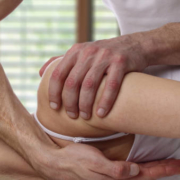Emergency Back Pain
“Osteopathic manipulative treatment reduced pain and improved function in patients suffering from chronic, nonspecific low back pain, research shows. Further, patients reporting the worst pain and higher degrees of disability received the most substantial benefit from the treatments” – Journal of the American Osteopathic Association /, February 2016
Back pain can be debilitating. Patients suffering from severe back pain often have trouble walking or even standing up. Lower back pain may be sharp or dull and may be severe enough to limit everyday activities. Pain may worsen with certain activities (such as sports with poor technique) or physical positions (such as sitting for long periods with poor posture) and may be relieved by rest. Irritation or compression of the sciatic nerve from your spine can cause pain and numbness or tingling in your leg and can limit your ability to sit, drive, walk, or go to work. Causes of back pain include accidents, muscle strains, sports injuries, poor posture, stress and mechanical problems involving the spine, infections and serious pathology.
When a back problem first occurs, it’s a good idea to first consult with an osteopath or doctor and make sure you are doing the right things for your back. If possible have someone else drive you for immediate assessment and treatment. You should consider seeking medical attention: If you develop a sudden onset of extreme low back pain or sciatica, if pain is severe even after taking medication and getting rest; if the pain follows a fall, car accident, sports injury; if you have numbness, tingling in your arms or your legs; if the pain is made worse by coughing or bending forward or backward at the waist; the pain extends downward along the back of the leg.
An osteopath will take a thorough medical history followed by an orthopaedic, neurological, and osteopathic examination leading to a diagnosis. The osteopath may refer for further investigations or other specialists as clinically appropriate. Early diagnosis is vital in achieving a speedy recovery. Osteopathic treatment for lower back pain depends upon the patient’s history and the type and severity of pain. Osteopaths will use techniques such as subtle joint articulation and adjustments, myofascial release, massage and cranial osteopathy which aim to help decrease pain, improve joint mobility, decrease muscle spasm, improve tissue circulation and lymphatic drainage which may reduce inflammation and aids recovery of nerves, muscles, ligaments and joints.
The osteopath will explain how bad posture and spinal wear and tear have contributed to your pain. You may be given specific exercises to do at home and other advice regarding ice and heat as well as advice on ergonomics in you work place and better posture. Much lower back pain can be managed conservatively without the need for surgery, and understanding its cause often is the key to avoiding re-injury. If pain persists or worsens, more involved diagnostic and surgical procedures may be recommended.
If you experience any of the following symptoms in conjunction with back pains, or as a result of severe trauma visit the nearest emergency room immediately. 1. Progressive leg weakness and/or loss of bladder or bowel sensation/control. 2. Unexplained weight loss, loss of appetite, pain and neurological problems. 3. Severe, continuous abdominal and lower back pain. 4. Sustained fever and increased pain. These symptoms could be a sign of a serious problem that requires medical attention right away.
View a list of common complains that Osteopathy can assist with
Discovery the benefits of Osteopathy
- What is Osteopathy?
- Adult health issues
- Babies and Children
- During and after pregnancy
- Common Complaints
- Testimonials
- Sports Injuries
- Genral Osteopathy FAQs
- The Science & Reasearch




